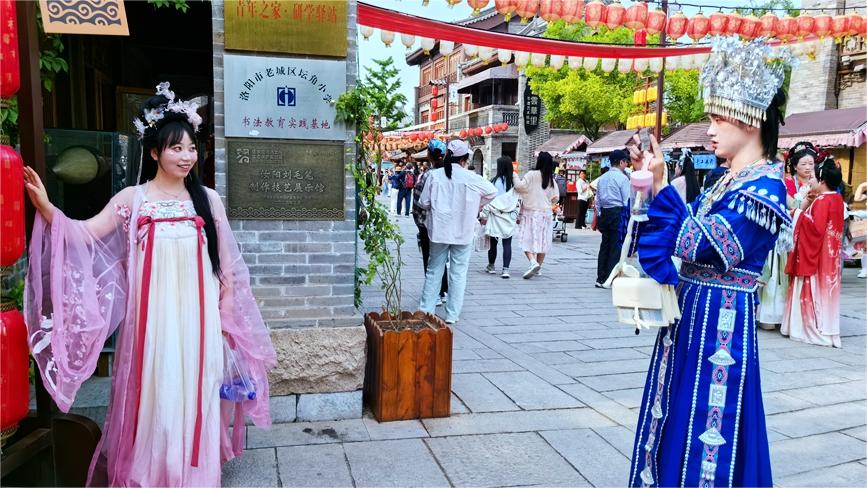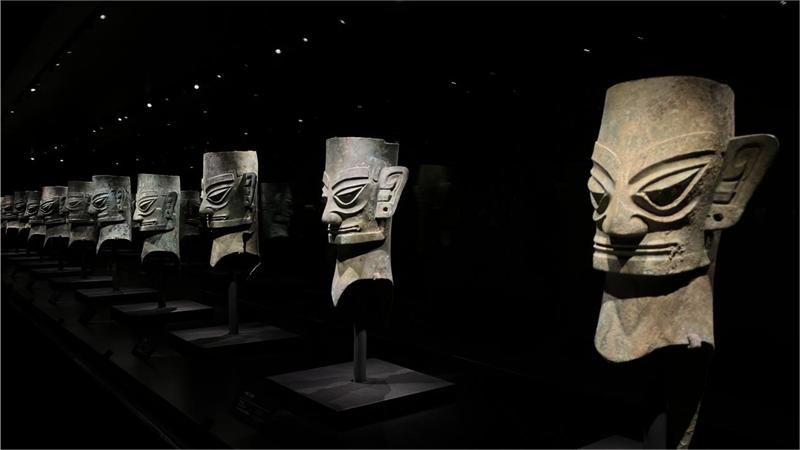Chinese astronauts return safely with six-month space station mission accomplished
* Shenzhou-17's return capsule, carrying astronauts Tang Hongbo, Tang Shengjie and Jiang Xinlin, touched down at the Dongfeng landing site in north China's Inner Mongolia Autonomous Region at 5:46 p.m. (Beijing Time).
* The three astronauts, after staying in orbit for 187 days, are all in good health and the Shenzhou-17 manned mission was a success.
* The Shenzhou-17 crew carried out 84 space application experiments and tests in orbit, and produced more than 200 samples covering multiple fields, including space life science and biotechnology, space medicine and space material science.
JIUQUAN, April 30 (Xinhua) -- The three Shenzhou-17 astronauts returned to Earth safely on Tuesday afternoon, after completing a six-month space station mission.
Shenzhou-17's return capsule, carrying astronauts Tang Hongbo, Tang Shengjie and Jiang Xinlin, touched down at the Dongfeng landing site in north China's Inner Mongolia Autonomous Region at 5:46 p.m. (Beijing Time), and the crew all left the return capsule by 6:37 p.m., according to the China Manned Space Agency (CMSA).
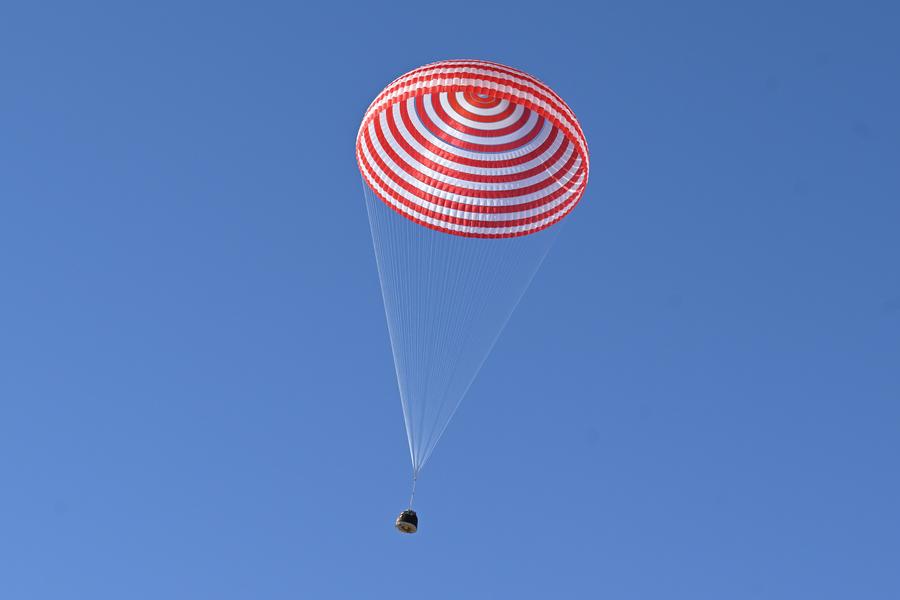
The return capsule of the Shenzhou-17 manned spaceship, carrying astronauts Tang Hongbo, Tang Shengjie and Jiang Xinlin, is about to touch down at the Dongfeng landing site in north China's Inner Mongolia Autonomous Region, April 30, 2024. (Xinhua/Li Zhipeng)
The three astronauts, after staying in orbit for 187 days, are all in good health and the Shenzhou-17 manned mission was a success, the CMSA said.
Tang Hongbo has accumulated a total of 279 days in space over the course of two missions, Shenzhou-12 and Shenzhou-17, setting a new record for the longest spaceflight duration by a Chinese astronaut. His experience has been invaluable to regular crew rotations and spaceflight mission training, according to the CMSA.
"I am proud and honored for my motherland," the 48-year-old mission commander said, sitting in front of the capsule. "While completing my tasks, I missed my motherland and hometown very much."
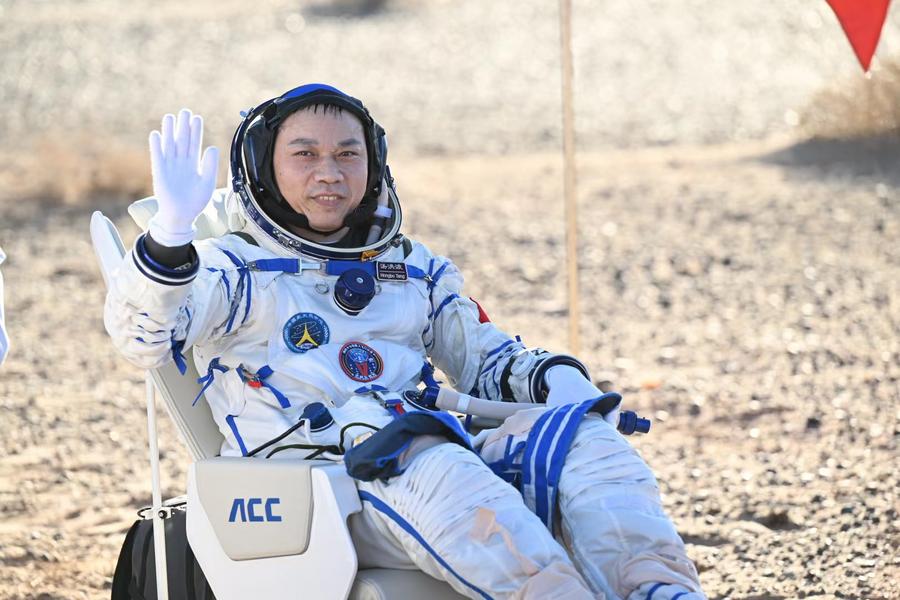
Astronaut Tang Hongbo is out of the return capsule of the Shenzhou-17 manned spaceship at the Dongfeng landing site in north China's Inner Mongolia Autonomous Region, April 30, 2024. (Xinhua/Bei He)
Tang Shengjie, 34, who has just completed his first space trip and is the youngest astronaut to have entered China's space station, said that the six months had been a journey of learning and exploration, during which he gained a lot of valuable experience. "I believe that fulfilling my dream of flying into space was not an endpoint but a new start."

Astronaut Tang Shengjie is out of the return capsule of the Shenzhou-17 manned spaceship at the Dongfeng landing site in north China's Inner Mongolia Autonomous Region, April 30, 2024. (Xinhua/Bei He)
Jiang, 36, who has also just finished his first spaceflight, said, "Now that I am back in the embrace of our motherland, my heart is filled with excitement. In the coming days, I will continue to work diligently on the recovery tasks and strive to return to space as soon as possible."
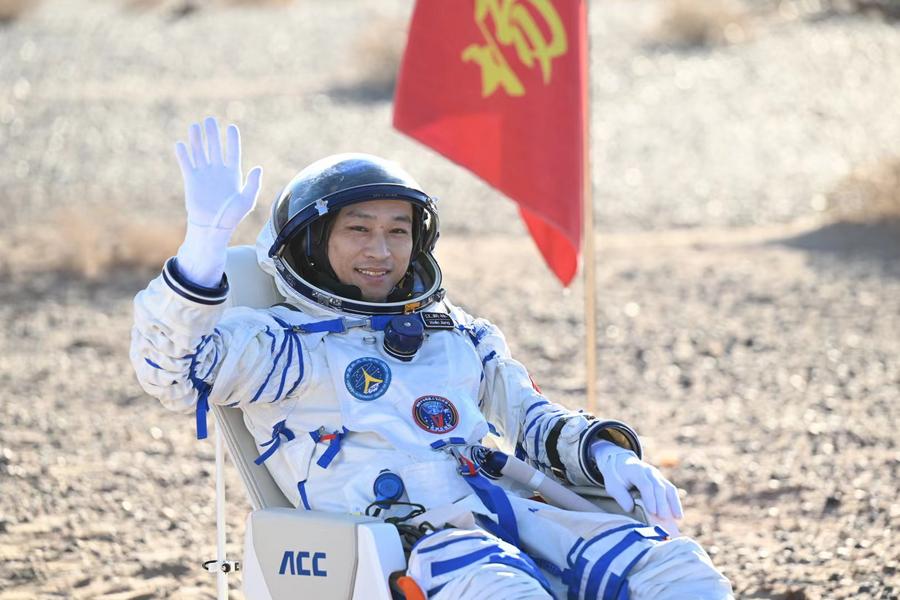
Astronaut Jiang Xinlin is out of the return capsule of the Shenzhou-17 manned spaceship at the Dongfeng landing site in north China's Inner Mongolia Autonomous Region, April 30, 2024. (Xinhua/Bei He)
The return capsule separated from Shenzhou-17's orbital capsule at 4:56 p.m. Then the brake engine ignited, and the return capsule separated from the propulsion capsule, the CMSA said.
Soon after the return capsule landed, the ground search team arrived at the landing site.
China launched the Shenzhou-17 manned spaceship on Oct. 26, 2023. It was the second crewed mission for the application and development stage of China's space station.
The Shenzhou-17 crew carried out 84 space application experiments and tests in orbit, and produced more than 200 samples covering multiple fields, including space life science and biotechnology, space medicine and space material science, said Lin Xiqiang, deputy director of the CMSA, at a press conference on April 24.
Scientists will conduct further in-depth analysis of and research on these samples, aiming to achieve significant scientific application results in areas such as the preparation of high-performance multivariant alloys and functional crystal materials, and the inhibition of bone loss through the differentiation of stem cells.

This screen image captured at Beijing Aerospace Control Center on March 2, 2024 shows Shenzhou-17 astronaut Tang Hongbo performing extravehicular activities. (Xinhua/Li He)
"In addition, the Shenzhou-17 mission also saw Chinese astronauts complete the first in-orbit maintenance of extravehicular facilities, fully showcasing the role of humans in addressing unforeseen issues encountered in space," Lin said.
The space station's core module, Tianhe, had previously suffered a partial loss of power supply due to the impact of space debris on the solar wing's power cables.
The Shenzhou-17 crew, in two extravehicular activities, completed maintenance work on the Tianhe core module's solar wings, solving the impact problem, according to Lin.
China launched the Shenzhou-18 manned spaceship on April 25, sending three astronauts -- Ye Guangfu, Li Cong and Li Guangsu -- to its space station for another six-month mission.
Photos
Related Stories
- China's Shenzhou-18 manned spaceship successfully launched
- China’s commercial aerospace companies speed up launch schedule following clear goal
- Rocket launch fuels youth space exploration dreams
- China to launch 3 lunar probe missions within next 4 yrs; ILRS to complete basic form before 2035: chief designer of lunar exploration projects
- Wuhan Declaration adopted at China-Latin American and Caribbean States Space Cooperation Forum
Copyright © 2024 People's Daily Online. All Rights Reserved.








